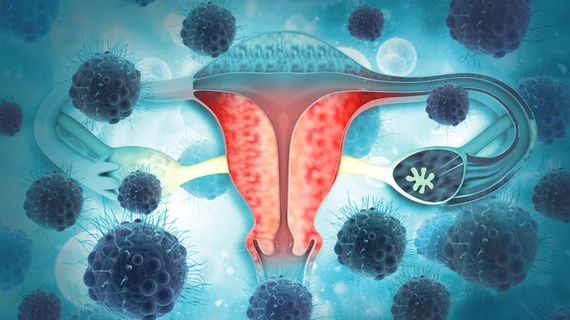Follow-up ultrasound ovarian imaging offers little benefit to patients, experts advise
Follow-up imaging of simple ovarian masses offers little to no benefit to women, and this practice should be curbed or discontinued, according to a new analysis.
The incidental spotting of these “simple cysts” has increased in recent years with greater use of CT and ultrasound. This oftentimes leads to many women undergoing US surveillance to keep an eye on the condition, Massachusetts General experts wrote in JACR.
But there is a lack of evidence indicating the benefits of such follow-up imaging. Wanting to close this knowledge gap, researchers built a model to estimate increases in life expectancy, surmising that this common practice may be largely unnecessary.
“We found that even under idealized scenarios of cancer detection and treatment, imaging follow-up of simple ovarian cysts affords modest benefits at best,” corresponding author Pari Pandharipande, MD, an associate professor of radiology at Harvard and MGH abdominal imaging specialist, and colleagues wrote Oct. 21.
To back up their claims, the research team used “decision-analytic modeling techniques” to simulate hypothetical cohorts of postmenopausal women, with varying ages and comorbidities. They then projected gains in life expectancy with regular follow-up at two years, or none at all. Researchers also assumed perfect ovarian cancer detection and treatment during follow-up for their model.
Pandharipande et al. determined that life expectancy gains were “limited.” For instance, women ages 66, 70, 75 and 80 with no comorbidities only gained roughly 3.7 to 5.1 additional days. And if they did have such conditions, the gains were between 2.1 and 3.5 days. Or if sensitivity for cancer dropped to 50%, the LE gain might be 3.7 days for a 66-year-old woman with no comorbidities, or 1.3 days for an 80-year-old with them.
“Ultrasound, or even ultrasound combined with tumor marker (CA-125) surveillance, is not capable of perfect cancer detection. Such tests perform poorly for early cancer detection in most patients,” the team noted. “Through exposing, in an overly optimistic scenario of cancer control, the small magnitude of benefits achievable from follow-up of simple ovarian cysts, our results support recent reductions in advised follow-up length, and possible elimination of follow-up recommendations for some women, particularly in those for whom the benefits are exceedingly small,” they added later.
Read more in the Journal of the American College of Radiology here.

